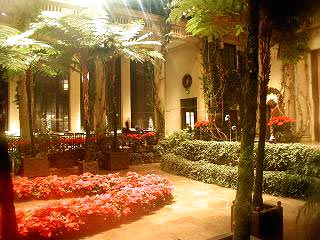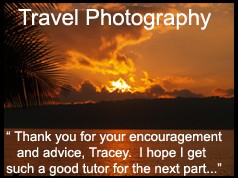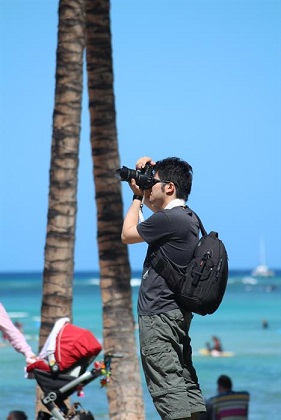Learn to Take Really Good Travel Photographs
- Take better travel photographs
- Indulge a passion, start a business or launch a career
Course structure
 There are eight lessons including a special project in this course:
There are eight lessons including a special project in this course:
- Introduction - To be able to take good travel photographs, the first essential is to know and understand the equipment and materials used in photography. Part of this first lesson is aimed to ensure that you have this basic knowledge.
- The Main Principles - This lesson aims to provide you with a firm understanding of how you can work at improving your capabilities with respect to taking travel photographs. It provides a framework, upon which you will base your work in future lessons.
- Creating Different Effects - Learn how to achieve different effects with snapshots and scenic shots.
- Photographing Natural Areas - Learn how to photograph wilderness shots and seascapes.
- Photographing Streetscapes - Learn the two main types of street photography: posed & candid
- Photographing Interiors - Look at the difficulties involved in photographing interior subjects and how to overcome them.
- Developing Your Photographic Style - By using photographic equipment skillfully and learning how to sense the way different types of film will respond to different colours and different situations (eg: haze, back light, side light, reflected light etc).
- Major Project
Aims
- Identify the scope of travel photography, and the resources required to take travel photos
- Explain how you can work at improving your capabilities with respect to taking travel photographs.
- Apply camera techniques including framing, positioning, timing and borrowed landscapes to create various effects.
- Photograph natural areas to make best use of their texture, or even give them human qualities.
- Photograph streetscapes to create different moods, or capture elements of your choice.
- Photograph indoor scenes making best use of available and artificial lighting.
- Create a series of travel photographs which contain a single common feature that differentiates them from other photographs, and in doing so, provides an indication that they are likely to have been taken by the same person.

This is a great course for anyone planning a special holiday. Over eight lessons, you will be shown how to achieve a quality record of your trip on film. You will learn techniques needed for photographing landscapes, streetscapes, wildlife, people and lots more. Your tutor will even advise you on what type of equipment you need and where to buy equipment and film.

TRAVELLING TIPS
- X-ray machines have been the dread of photographers since they first came into use in airports. Recent studies, though, have shown that even frequent exposure to well-maintained X-ray machines in developed countries does little or no damage to films. Machines in undeveloped and smaller countries are not as carefully monitored. The exception to this is very fast films (ISO 400 and faster), because their added sensitivity makes them more susceptible to potential damage.
- The quantity of memory cards or film required really depends on your shooting habits. Some people never shoot more than 100 shots a day; others more, others a lot less. Always, bring double the amount you think you will need. Film is very expensive in tourist destinations, and it's a major hassle to have to interrupt your touring to go looking for it.
- Batteries are often difficult to find on the road, so always bring an extra or two. Most cameras are useless without them. If using a digital camera makes sure your battery is fully charged before travelling.
- Buying equipment abroad is not always a good idea. In the face of duties, and unusable warranty arrangements, buy cameras abroad only if the one you bring dies or is lost. For backup you can bring several one-time-use cameras; these are also great if you are making a side trip to someplace where you don't want to risk your real camera--a rafting excursion or rainy-day hike, for example.
- Very humid, tropical climates can ply up with some cameras. When travelling to such areas, it may be best to seek advice before arriving somewhere and finding your lens is fogging up.